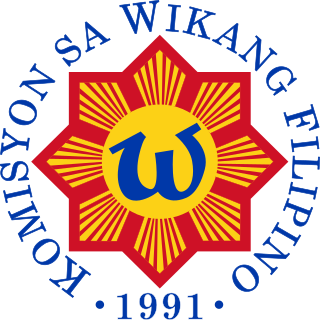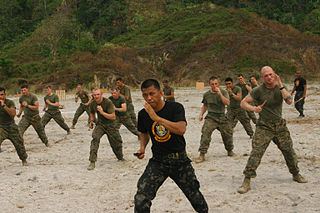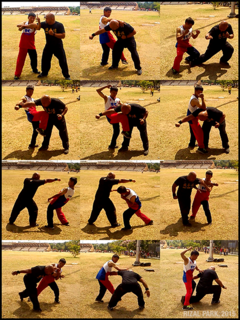Related Research Articles

Grappling, in hand-to-hand combat, describes sports that consist of gripping or seizing the opponent. Grappling is used at close range to gain a physical advantage over an opponent, either by imposing a position or causing injury. Grappling is a broad term that encompasses many disciplines. These various martial arts can be practiced both as combat sports and for self-defense. Grappling contests often involve takedowns and ground control, and may end when a contestant concedes defeat, also known as a submission or tap out.
Martial arts are codified systems and traditions of combat practiced for a number of reasons such as self-defense; military and law enforcement applications; competition; physical, mental, and spiritual development; entertainment; and the preservation of a nation's intangible cultural heritage.

Filipino martial arts (FMA) refer to ancient Malay and newer modified fighting methods devised in the Philippines. It incorporates elements from both Western and Eastern Martial Arts, the most popular forms of which are known as Arnis, Eskrima, and Kali. The intrinsic need for self-preservation was the genesis of these systems. Throughout the ages, invaders and evolving local conflict imposed new dynamics for combat in the islands now making up the Philippines. The Filipino people developed battle skills as a direct result of an appreciation of their ever-changing circumstances. They learned often out of necessity how to prioritize, allocate and use common resources in combative situations. Filipinos have been heavily influenced by a phenomenon of cultural and linguistic mixture. Some of the specific mechanisms responsible for cultural and martial change extended from phenomena such as war, political and social systems, technology, trade and practicality.
Dumog is the Filipino style of wrestling while standing upright and refers to the grappling aspect of Filipino martial arts. The word dumog is most commonly used in Mindanao and the Visayas, while the word buno is used in Luzon, specifically in the Southern Tagalog-speaking provinces as far south as Mindoro. Tribal groups such as the Ifugao, Samal, Igorot, Ibanag, Manobo, Dumagat, and Maranao are said to practice grappling arts known respectively as bultong, silaga, dama, garong, buteng, purgos, and kapulubod; while ethnic groups such as the Tagalog, Ilokano, Cebuano, Bicolano, Pampanga, and Pangasinan, are said to practice grappling arts known as gabbo, layung, lampugan, pantok, balsakan, and dumog.

Mangyan is the generic name for the eight indigenous groups found on the island of Mindoro, southwest of the island of Luzon, the Philippines, each with its own tribal name, language, and customs. The total population may be around 280,000, but official statistics are difficult to determine under the conditions of remote areas, reclusive tribal groups and some having little if any outside world contact.

The Commission on the Filipino Language (CFL), also referred to as the Komisyon sa Wikang Filipino (KWF), is the official regulating body of the Filipino language and the official government institution tasked with developing, preserving, and promoting the various local Philippine languages. The commission was established in accordance with the 1987 Constitution of the Philippines.
San Miguel Eskrima is one of the major systems of eskrima, a martial arts from the Philippines. Founded by Filemon "Momoy" Cañete of the Doce Pares Club, SME served as vehicle for his own personal expression of the art and methodology of the club of which he was a co-founder and instructor. The name San Miguel is taken from Michael (archangel), the slayer of Satan, and is one of the major strikes used in Eskrima.

Pekiti-Tirsia Kali is a style specific to Filipino Martial Arts. Pekiti-Tirsia Kali was founded in 1897 and is the system of the Tortal family. The sole heir and guardian of this system is Leo T. Gaje Jr.. Pekiti-Tirsia is strictly a combat-oriented system, as opposed to a sport-focused fighting style. It is a fighting system that focuses on edged, impact and improvised weapons. PTK has been adopted as the preferred combative training program by elite military and law enforcement units around the world. It claims to be a very lethal fighting method for self-defence.

A folk wrestling style is any traditional style of wrestling, which may or may not be codified as a modern sport. Most cultures have developed regional forms of grappling.

Sibat is the Filipino word for spear, used as a weapon or tool by natives of the Philippines. The term is used in Tagalog and Kinaray-a. It also called bangkaw, sumbling or palupad in the islands of Visayas and Mindanao; and budjak among Muslim Filipinos in western Mindanao and the Sulu Archipelago.
The Buhid language is a language spoken by Mangyans in the island of Mindoro, Philippines. It is divided into eastern and western dialects.
The Tadyawan language is a language spoken by Mangyans in the southern Lake Naujan in Oriental Mindoro, Philippines.
Hanunoo, or Hanunó'o, is a language spoken by Mangyans in the island of Mindoro, Philippines.
The Alangan language is a language spoken by Mangyans in the province of Mindoro in the Philippines.
Garimot Arnis is a Filipino martial art developed by Gat Puno (Chieftain) Abon "Garimot" Baet. He is the 5th generation inheritor of his family art. Garimot Arnis is a system composed of three basic parts: arnis de mano (weapons), buno (wrestling), and hilot (healing). The defining characteristic of the system is in keeping yourself safe. This is done by meticulously studying the footwork, angles, and distancing of largo mano to keep yourself out of your opponent's range while keeping him in your range. In corto (close) range, the opponent's ability to attack must be shut down as quickly as possible, through a disarm, lock, or manipulation of the opponent's body, which sets up the finish. Above all, knowledge of hilot allows you to keep yourself healthy by helping to fight illness and injuries, especially injuries caused during arnis and buno training.
Benjamin Abadiano is a Filipino lexicographer who has worked in the country's highlands with the Mangyan, Lumad, and other indigenous peoples. He did volunteer work for nine years in Paitan, Oriental Mindoro, and later in Mindanao. He was awarded the 2004 Ramon Magsaysay Award for Emergent Leadership.
The Southern Mindoro languages are one of two small clusters of Austronesian languages spoken by the Mangyan people of Mindoro Island in the Philippines. They make up a branch of the Greater Central Philippine subgroup.
The Northern Mindoro languages are one of two small clusters of languages spoken by the Mangyan people of Mindoro Island in the Philippines.
Bultong is the Ifugao name for their sport of traditional wrestling. It is often played during town and provincial fiestas. Bultong falls under the international classification of "belt wrestling".

Suntukan is the fist-related striking component of Filipino martial arts. In the central Philippine island region of Visayas, it is known as Pangamot or Pakamot and Sumbagay. It is also known as Mano-mano and often referred to in Western martial arts circles of Inosanto lineage as Panantukan. Although it is also called Filipino Boxing, this article pertains to the Filipino martial art and should not be confused with the Western sport of boxing as practiced in the Philippines. In recent times, suntukan has become a generalized term for any brawls in the Philippines, with the term panantukan becoming more frequently used to denote the actual martial art.
References
- ↑ Philippine Online Dictionary
- 1 2 Harimaw Buno Archived March 16, 2008, at the Wayback Machine
- 1 2 Books About Filipino Martial Arts You Should Have In Your Library Archived June 25, 2007, at the Wayback Machine